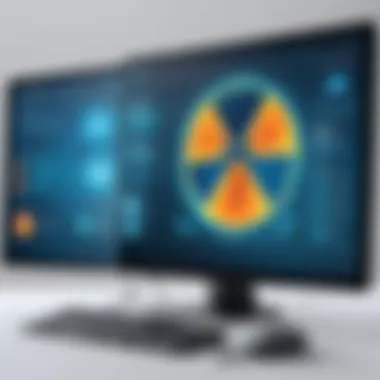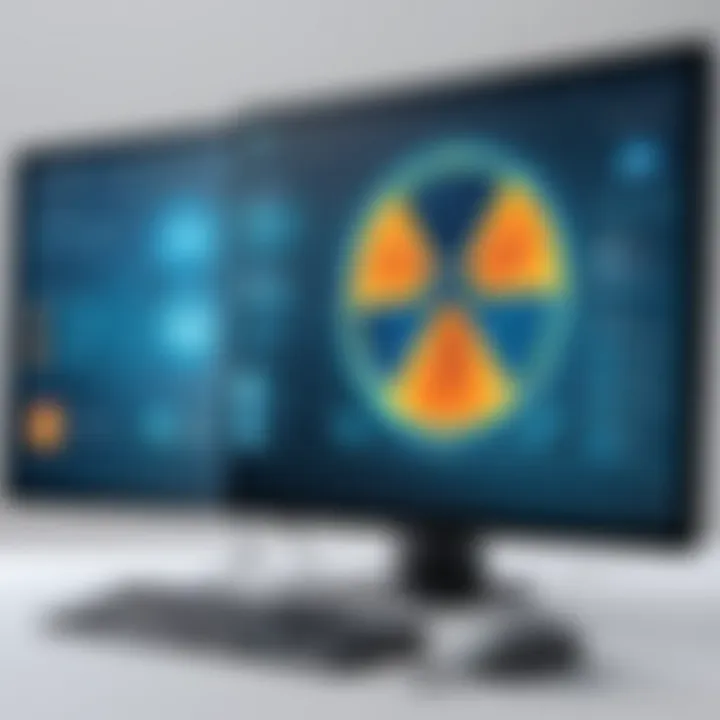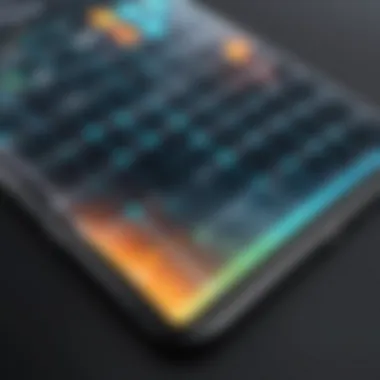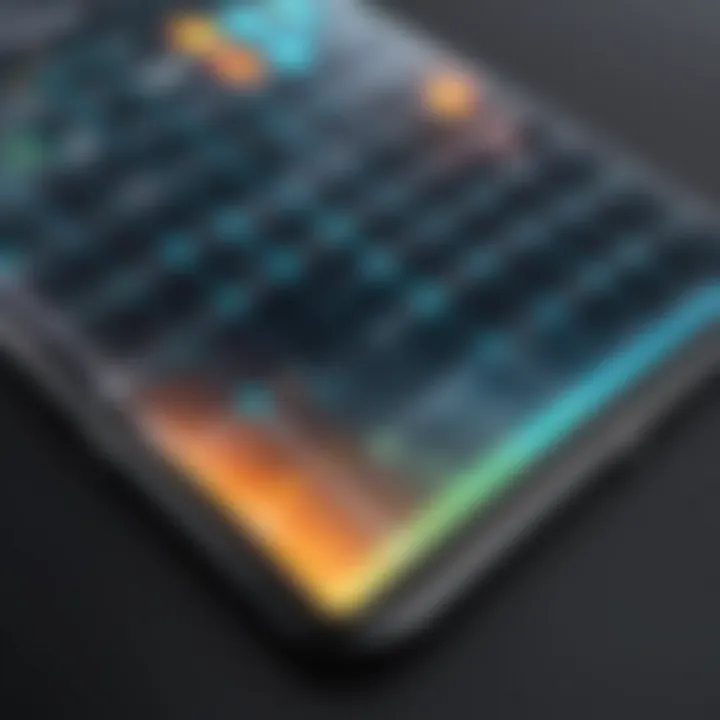Understanding Computer Screen Radiation Protectors


Intro
In the modern world, our interaction with technology is deeper than ever. Computers are central to daily life, both for work and leisure. However, increased screen time raises concerns about the potential health effects of computer screen radiation. This analysis serves to clarify the nature of electromagnetic radiation emitted by screens and the role of radiation protectors in possibly reducing associated risks.
The relevance of understanding computer screen radiation protectors cannot be overstated. As more individuals seek to create comfortable and safe digital environments, the ability to make informed decisions about available products plays a crucial role. Some may wonder if these devices are necessary or merely an exaggeration from a technologically aware community.
Through this article, we aim to explore key concepts surrounding screen radiation and the effectiveness of protective devices. We will also examine how to assess personal usage patterns and appropriate solutions for various needs. This comprehensive guide aims to equip readers with knowledge and strategies to effectively navigate their digital experiences.
Intro to Computer Screen Radiation
The relevance of understanding computer screen radiation cannot be understated in today's digital-centric world. As technology advances and computer screens become an essential part of our daily lives, awareness about the types of radiation emitted and their potential impact on our health grows more critical. In this section, we will delve into the nature of electromagnetic radiation, its sources, and how they intertwine with our interactions with various digital devices.
Defining Electromagnetic Radiation
Electromagnetic radiation refers to energy waves that travel through space at the speed of light. This includes a broad spectrum, from gamma rays to radio waves. The type of radiation of most concern in relation to computer screens falls within the non-ionizing category, which includes visible light, infrared light, and radiofrequency radiation.
The significance of categorizing these types lies in understanding their energy levels and the potential risk they pose. Non-ionizing radiation, as emitted from screens, does not have enough energy to remove tightly bound electrons from atoms. It is essential, however, to recognize that extended exposure, even to non-ionizing radiation, may lead to various health issues.
Sources of Radiation in Technology
The digital landscape presents multiple sources of radiation. Devices such as desktop computers, laptops, tablets, and smartphones all emit varying levels of radiation. The intensity of this radiation can differ significantly based on the technology used in each screen type.
- Cathode Ray Tube (CRT) Monitors: The older CRT technology emits visible light and low levels of X-rays, which can be concerning with prolonged exposure.
- LCD and LED Screens: Modern LCD and LED screens are more efficient but still emit blue light and other forms of non-ionizing radiation that might affect eye health.
- OLED Technologies: OLED displays, favored for their deeper blacks and vibrant colors, also emit blue light, raising similar concerns as LCDs and LEDs.
"Every kind of screen has its unique emission profile. Understanding these profiles helps in assessing the need for protective measures."
While all these sources contribute to our screen time radiation exposure, the focus should remain on understanding how this exposure compiles over time and what protective measures are advisable to maintain optimal health. Awareness of the sources is a critical step toward making informed decisions about device usage and protective solutions.
Types of Computer Screens and Their Emissions
Understanding the different types of computer screens and their emissions is vital in comprehending the risks associated with screen radiation. Each type of display technology has distinct characteristics that contribute to their radiation profiles. This section examines three main types of screens: Cathode Ray Tube (CRT) monitors, LCD and LED screens, and OLED technologies. By dissecting the emissions from each category, users can gain clearer insights into the efficacy of radiation protectors.
Cathode Ray Tube (CRT) Monitors
CRT monitors use electron beams that strike a phosphorescent screen to produce images. While this technology is largely outdated, many people still encounter it, especially in older setups. CRTs emit various types of electromagnetic radiation, including low-frequency electromagnetic fields (EMF).
The emissions from CRT monitors can lead to concerns about long-term health effects. Some studies suggest that prolonged exposure to EMF might increase the risk of certain health issues. However, modern regulations ensure that CRTs released into the market meet safety standards. Users should still be aware of the potential exposure, particularly in environments where older monitors exist.
and LED Screens
Liquid Crystal Displays (LCD) and Light Emitting Diode (LED) screens have largely replaced CRT technology in modern computers. Both types offer significant benefits like thinner designs and higher energy efficiency. However, they also come with their radiation considerations.
LCDs primarily emit a very low level of radiation, significantly less than CRT monitors. This is advantageous for prolonged use. LED screens, which are essentially a type of LCD using LEDs for backlighting, retain this low radiation profile, making them suitable for users who spend extended periods in front of a screen. Despite their advantages, careful attention to the distance from the screen and proper lighting can further mitigate any potential risks from prolonged exposure.
OLED Technologies
Organic Light Emitting Diodes (OLED) represent a cutting-edge technology. OLED screens offer vibrant color and excellent contrast ratios due to their ability to light individual pixels. This technology produces less heat and typically has a better response time than earlier screen types.
When considering emissions, OLED screens generate lower levels of radiation compared to CRTs. They also mitigate flicker rates, which can lead to eye strain over time. Nonetheless, some users have expressed concerns about blue light emission from OLED displays. Blue light can impact sleep patterns and cause discomfort in the eyes. Therefore, utilizing screen filters or software solutions to reduce blue light exposure is advisable for those using OLED technology extensively.
Health Implications of Screen Radiation Exposure
Understanding the health implications of screen radiation exposure is crucial in today's technology-driven world. As individuals spend increasing time in front of computer screens, recognizing the potential health risks associated with radiation becomes vital. This section will delve into various aspects of screen radiation exposure, its chronic effects, common symptoms exhibited by users, and the scientific findings surrounding these risks. By looking deeply into these elements, readers will gain knowledge that can influence their decisions on screen usage and protective measures.


Understanding Chronic Exposure Risks
Chronic exposure to radiation emitted from computer screens can lead to various health complications. Some research suggests that prolonged interactions with screens, especially at close distances, may lead to potential long-term effects. This includes risks related to electromagnetic radiation, which could contribute to issues like eye strain, sleep disturbances, and even some forms of cancer over extensive periods. The cumulative exposure is concerning, particularly for those who work in environments where screen time is excessive. Understanding these risks allows users to assess their habits and consider whether protective measures might be necessary to mitigate potential dangers.
Common Symptoms of Overexposure
Awareness of common symptoms linked to radiation overexposure is essential for early detection and intervention. Symptoms may vary among individuals, but some frequent reports include:
- Eye fatigue or discomfort, often referred to as digital eye strain
- Headaches after prolonged screen use
- Impaired sleep quality, particularly when screens are used late at night
- Increased sensitivity to light
- Dry or irritated eyes
Recognizing these symptoms is a critical first step in mitigating any adverse effects; understanding when these signs occur can prompt users to adjust their habits appropriately. If individuals frequently experience these issues, it may be time to evaluate their screen use or consider utilizing radiation protection solutions.
Scientific Research Findings
There is a wealth of scientific research aimed at understanding the effects of screen radiation on health. Various studies have investigated the degree of risk associated with different screen types and usage patterns. Some findings indicate that while the levels of radiation emitted from modern screens are relatively low, their long-term impact should not be overlooked. According to a study published on Scientific American, certain radiation levels generated by monitors can have lasting effects on our biological systems, even if immediate symptoms do not appear right away. Many conclude that further research is necessary to fully understand the implications of ongoing exposure to screen radiation, emphasizing the need for vigilance and informed decision-making by the user.
"While the consensus indicates that modern computer screens emit low levels of radiation, the potential health effects cannot be dismissed due to the cumulative nature of exposure."
Understanding Radiation Protectors
Radiation protectors for computer screens serve a crucial role in today's digital age. As individuals increasingly rely on screens for both work and leisure, understanding the protection these devices can offer becomes essential. People are often exposed to electromagnetic radiation emitted from various devices, which raises health concerns. Thus, radiation protectors offer a way to lessen this exposure, whether one is an office worker spending hours on a computer or a gamer immersed in virtual worlds.
Types of Radiation Protectors
There are several types of radiation protectors available, each designed to minimize different aspects of screen radiation.
- Screen Filters: These are thin overlays placed directly on the screen surface. They can filter out harmful blue light and reduce glare, contributing to a more comfortable viewing experience. These filters often come in various sizes to fit different screens.
- Protective Shields: These are standalone units that can be positioned in front of the monitor. Unlike screen filters, they encompass broader radiation shielding capabilities. They are typically heavier and provide a more comprehensive barrier against emissions.
- Anti-Glare Coatings: Though primarily designed to reduce reflections, these coatings can also help mitigate some radiation exposure. They are generally useful in office settings where lighting plays a critical role in screen visibility.
- Wearable Protectors: Some products are designed for the user rather than the screen, such as glasses with special coatings. They aim to protect the eyes from blue light emitted by screens. This option may appeal to those who spend substantial time facing multiple devices simultaneously.
It is important to note that while these products promise protection, their effectiveness can vary based on specifications and usage.
Material Effectiveness and Specifications
The effectiveness of radiation protectors largely hinges on the materials used in their construction. Typically, materials are chosen for their ability to absorb or deflect electromagnetic radiation.
- Polycarbonate: This is a common choice for screen filters. It is lightweight and provides reasonable protection against radiation without significant distortion of the display.
- Glass: Some higher-end screen protectors utilize tempered glass. While more durable, the effectiveness against radiation heavily depends on the specific coatings or properties of the glass.
- Metals: Certain shields employ metals known for electromagnetic interference shielding. Materials like aluminum are effective but may not be practical for everyday screen use due to bulkiness.
When selecting a radiation protector, pay close attention to the product specifications. Look for certifications that indicate standards have been met regarding radiation emissions reduction. Users should ensure clear visibility and usability, balancing protection with ease of use.
Evaluating the Effectiveness of Radiation Protectors
Evaluating the effectiveness of radiation protectors is essential to understanding their true value in the context of health and safety. Given the increasing reliance on digital devices in our daily lives, an informed assessment of these products helps users make choices that can influence their well-being. The claims made by manufacturers can often be misleading, emphasizing the need for scrutiny. This section will delve into key aspects such as scientific evidence, real user feedback, and how these elements play into a more comprehensive evaluation of radiation protectors.
Manufacturer Claims vs. Scientific Data
Evaluating the claims made by manufacturers is crucial. While many companies assert that their radiation protectors significantly reduce exposure to harmful radiation, the scientific backing for these claims can vary widely.
- Verification of Claims: Many products promote features like shielding capabilities, but understanding how these claims are supported by data is fundamental.
- Independent Studies: Independent research can serve as a benchmark. Articles published in peer-reviewed journals often provide a more objective perspective, comparing the effectiveness of various protectors based on empirically gathered data.
- Standards and Certifications: Organizations like the American National Standards Institute (ANSI) establish guidelines for safety. Checking if a product meets these criteria can lend credibility to its claims.
"Scientific scrutiny of product effectiveness is crucial. Relying solely on marketing strategies may jeopardize user safety."
User Experiences and Testimonials
User experiences offer crucial insight into the practical effectiveness of radiation protectors. Testimonials, while subjective, can reveal patterns and trends that statistical data might miss.


- Real-Life Usage: Users who have employed specific products over time can provide anecdotes regarding their experiences, including any noticeable differences in symptoms or comfort levels while using screens.
- Common Themes: Look for recurring themes in testimonials. A multitude of users citing similar experiences can lend weight to the effectiveness of a particular product.
- Social Media and Forums: Platforms like Reddit can be treasure troves for consumer feedback. Many users share their recommendations and warnings about products they have tried.
As potential buyers consider their options, it is wise to analyze both the scientific evidence and real-world experiences. This two-pronged approach can greatly enhance the understanding of how well these radiation protectors perform in everyday use.
Guidelines for Selecting a Radiation Protector
Selecting a radiation protector is a necessary step for those concerned about potential health risks from computer screen emissions. It is crucial to consider several factors during this process. A well-chosen radiation protector can enhance your digital environment and promote safety, especially for long hours of screen time.
The first element to evaluate is your personal usage and specific needs. Different users have varying patterns of computer use, from casual browsing to intensive gaming or professional tasks. Reflecting on how often and for what purpose you use your screens can inform which type of protector is best suited for you. Not all radiation protectors are equal; some are designed more for specific situations, so understanding your needs is key.
Assessing Personal Usage and Needs
Before making any purchase, evaluate your daily interaction with screens. How many hours do you spend in front of the computer? Is your work demanding on vision, such as graphic design or extensive research? High exposure may necessitate a more robust radiation solution. Also, consider your environment: a bright or reflective one can also warrant a specific type of protection.
It may help to keep a diary of your screen time. This can assist in highlighting patterns and influencing your decision. For example, if you consistently work late at night, a protector that minimizes blue light may be highly beneficial.
Budget Considerations
Financial aspects play a vital role in purchasing decisions. Radiation protectors come in various price ranges. It's wise to set a budget that reflects the importance of screen safety to you. While cheaper products might seem appealing, they may not offer substantial protection or durability.
Investing in a high-quality protector can be justified if it lowers health risks significantly. Check for options that provide a good balance of affordability and effectiveness. Look for discounts or deals online but be wary of overly cheap options that lack scientific backing.
Product Certification and Standards
Once you have assessed your needs and budget, it is vital to explore product certifications. Not all radiation protectors are certified, and this fact can greatly affect their reliability. Research organizations or manufacturers that provide verified testing data regarding their products. Look for certifications that prove compliance with safety standards, which may vary by region.
Certifications ensure that the product has been scientifically evaluated and deemed effective in reducing radiation exposure. Such transparency can foster trust and cement your investment choice. Check manufacturer websites and credible review platforms for verified information.
"Selecting the right radiation protector combines personal needs, budget constraints, and certification standards for maximal safety and value."
Ultimately, making an informed decision about radiation protectors will lead to a safer digital interaction experience, improving overall well-being while using technology.
Alternatives to Radiation Protectors
The discussion on alternatives to radiation protectors is crucial in understanding how individuals can effectively safeguard themselves against potential health risks associated with computer screen radiation. While many users may lean towards physical devices, adjusting habits and settings offers a profound method for reducing exposure without additional costs. This section explores key strategies that can be implemented by anyone using screens regularly.
Adjusting Screen Settings for Safety
Adjustments to the settings on your computer screen can lead to a noticeable improvement in safety. Most screens come with options to alter brightness, contrast, and color temperature, which can help reduce glare and eye strain. For instance, reducing brightness to a comfortable level can decrease the amount of blue light emitted, which is often linked to discomfort during prolonged use.
Furthermore, many operating systems provide features such as night mode or blue light filters. These settings not only adjust color temperature but can also help in reducing overall eye fatigue. It’s essential to take a moment to explore these options, as they usually require minimal effort and can lead to significant comfort improvements.
Maintaining Safe Distance from Screens
Another effective strategy involves maintaining a safe distance from the screen. The position of your monitor can impact the level of radiation exposure you experience. Ideally, the monitor should be placed at least an arm's length away. This distance helps minimize direct exposure to emissions while also promoting proper posture. Furthermore, ensuring that the top of the screen is at or slightly below eye level encourages better viewing angles.
The ideal distance may vary depending on the screen size and resolution. Users with larger monitors, such as 27 inches or more, might need to adjust their distance accordingly. Regular breaks away from the screen are also advisable, as they allow your eyes to rest and reduce fatigue.
Limitations and Best Practices
Using alternatives to radiation protectors comes with its own limitations. Adjusting screen settings and maintaining distance can enhance comfort but may not completely eliminate all exposure risks. Therefore, it is essential to integrate these practices with other protective measures.
Best practices include:


- Taking regular breaks after every hour of screen time.
- Using anti-glare screens or coatings if settings alone do not suffice.
- Ergonomically arranging your workspace to support healthy posture and distance.
- Educating yourself on the signs of eye strain and irritation, allowing for timely action.
Effective management of screen exposure integrates behavioral changes with physical arrangement and technology tweaks.
By implementing these strategies, users can significantly enhance their screen experience. It becomes crucial to cultivate these habits, as they lead to a more sustainable and comfortable interaction with technology.
Future Directions in Radiation Protection Technologies
The exploration of future directions in radiation protection technologies is essential for addressing concerns about electromagnetic radiation emitted by computer screens. With technology rapidly advancing, understanding how these changes could enhance protection measures is crucial for both users' health and safety. As chronic screen exposure increases in daily life, so too does the need for effective mitigation strategies against potential radiation effects.
Innovations in Protective Materials
Recent developments in protective materials hold promise for enhanced effectiveness in radiation shielding. Researchers are exploring various substances that can minimize the impact of electromagnetic radiation while being practically applicable for everyday use. For example, materials such as graphene and nanocomposites demonstrate significant potential due to their lightweight and durable nature.
These materials have superior shielding properties compared to traditional options. They could be integrated into screen protectors or utilized in overarching protective devices designed to reduce exposure. Some key benefits of innovative materials include:
- Increased efficiency in blocking radiation: New materials can block a wider range of wavelengths more effectively than older technologies, improving user safety.
- Enhanced flexibility: Advanced materials can be designed to fit various screen shapes and sizes without compromising visibility or usability.
- Durability and longevity: Innovations allow for longer-lasting protective solutions that require less frequent replacement, providing convenience and cost savings for users.
This innovation trajectory not only highlights the technological advancements but also emphasizes the necessity of ongoing research in material science. As technology converges on safer options, users can expect a range of effective solutions tailored to combat screen radiation's adverse factors.
Potential for Smart Technology Integration
The potential integration of smart technology into radiation protection devices could significantly change the landscape of user safety. By utilizing sensors and smart algorithms, future protective devices can adapt in real-time to the user’s exposure, providing personalized feedback and mitigation options.
Smart technology can offer various advantages:
- Real-time monitoring: Devices equipped with sensors can continuously measure radiation levels and notify users when thresholds are exceeded.
- Automated adjustments: Protectors that utilize smart features can automatically adjust settings based on environmental conditions, minimizing radiation exposure in a more dynamic way.
- User engagement: Integrating apps or control systems allows users to monitor their usage patterns and screen exposure effectively, promoting healthier habits.
"The integration of smart technology into radiation protection is not just a possibility; it is emerging as a necessity in our increasingly digitized lives."
This shift towards smart solutions represents a leap in how users interact with protective technologies, enhancing their understanding and control over their digital environments. As research and development continue, the convergence of protective materials and smart technology could redefine how we approach safety in our computer usage, making informed choices not just available but intuitive.
End: Making Informed Decisions
Making informed decisions about computer screen radiation protectors is crucial in today’s technology-driven world. As we spend increasing amounts of time in front of screens, understanding the implications of screen radiation cannot be understated. The choices we make regarding radiation protection have a direct impact on our health and comfort.
When engaging with computer screens, users should consider several specific elements. First, knowledge of the types of radiation emitted by various screen technologies allows individuals to better gauge their risk. As discussed in previous sections, different screens—such as CRTs, LCDs, and OLEDs—emit varying levels of electromagnetic radiation.
Key benefits of selecting the right radiation protector include:
- Reducing symptoms of overexposure, such as eye strain and fatigue.
- Enhancing overall screen experience and comfort.
- Aligning product choice with personal usage patterns and budgets.
Considering these factors ensures that protective strategies are tailored to individual needs. Additional aspects, like the materials used in protectors and their efficacy, play a significant role in the overall defense against radiation. Good quality products often provide better shielding and comfort. Thus, users should prioritize certified options that adhere to recognized standards.
Ultimately, informed decision-making in this area drives better health outcomes and a more pleasant digital experience.
Recap of Key Points
Throughout this article, we have explored numerous vital aspects of computer screen radiation protectors. Here are the key points summarized:
- Understanding Radiation: We defined electromagnetic radiation and identified key sources in our digital environments.
- Types of Screens and Emissions: Different screen technologies emit various levels of radiation, with CRTs having significant emissions compared to modern LCDs and OLEDs.
- Health Risks of Exposure: Chronic exposure can lead to numerous health implications, making awareness paramount.
- Radiation Protectors: Various types of protectors exist, with distinctions in materials and effectiveness based on usage.
- Evaluating Efficacy: Manufacturer claims should be weighed against scientific studies and user experiences.
- Selecting a Protector: Factors like personal needs, budget, and product certifications are essential when choosing a protector.
- Alternatives: Screen settings, distance management, and overall best practices can enhance safety.
- Future Directions: Innovations in protective materials and smart technology that can respond to radiation levels are on the horizon.
Final Thoughts on Screen Protection
As you navigate your digital environment, consider incorporating protective measures as a fundamental step in safeguarding your well-being. This informed approach supports a healthier future amid the increasing demands of technology.
"Awareness of screen radiation and proactive protection leads to better health outcomes and enhanced screen experiences."
With thoughtful consideration and research, individuals can choose wisely, ensuring their technology use remains a positive and sustainable element of their daily lives.







